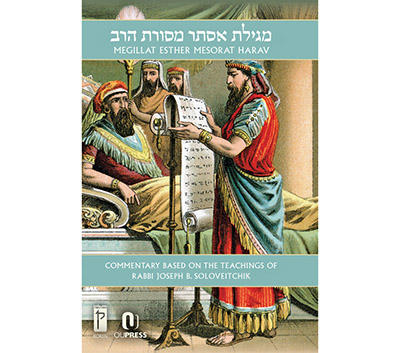
Reviewing: Megillat Esther Mesorat HaRav (Hebrew and English Edition), by Rabbi Joseph B. Soloveitchik, Koren Publishers Jerusalem/OU Press, hardcover, 224 pages, ISBN-10: 9653011847, January 2017.
The book of Esther reads like a novella—palace intrigue, bad marriages, military danger, sudden reversal of fortunes. However, from that perspective, the last two chapters seem out of place, focused as they are on legal details. The truth is that the entire book contains multiple layers of narrative, law, religious guidance and more. For a commentary to recognize this complex nature of the book, it must account for all these different perspectives embedded within the text.
In the recently published Megillat Esther Mesorat HaRav, the commentary—based on the teachings of Rabbi Joseph B. Soloveitchik (the “Rav”)—offers insight on many of these levels. Regarding the literary structure, the Rav asks why the book begins with the story of Achashverosh’s parties, Vashti’s refusal to cooperate with the king’s offensive demand, her execution and his new law demanding that wives respect their husbands. A concise story would focus on Esther, saying briefly that she was chosen to replace a queen who disobeyed the king. The Rav explains, based on the Gemara (Megilla 12b), that the king’s obviously ridiculous law undermined his prestige in the public eye. Because the populace did not trust the seriousness of his orders, they waited rather than immediately executed the order to kill the Jews. This first episode serves an important plot function in the Purim story.
Why does the text refer to Mordechai as “a Jewish man in the imperial city of Shushan” (Esther 2:5)? Surely many Jewish men lived there. The Rav explains that the term “Jewish man,” “ish Yehudi,” conveys more than ethnicity or religious affiliation. An “ish Yehudi” is someone with “commitment, determination and a sense of responsibility, ready to sacrifice, not embarrassed to protest in front of the royal palace.”
Mordechai was more than just Jewish—he was a proud Jew who publicly embraced that identity in all its meaning. He was a Jew at home and in the street, commited to fully acting on his beliefs and taking them to their conclusion. He was a profound believer and a determined activist. Even living in the imperial capital, surrounded by the trappings of power and indulgence, he refused to compromise his identity and his beliefs.
When Esther argued against Haman to Achashverosh, she made the seemingly disingenuous claim that she would not have objected had Haman wanted to enslave the Jews (Esther 6:4). The Rav shows a deeper meaning to Esther’s comments. There are many ways for a government to punish people. Haman chose a path that would arm civilians, those most loyal to his cause. Once Haman’s minions were armed, they could easily be turned against the king in a rebellion. Esther was playing on Achashverosh’s paranoia, directing the king to consider Haman’s plot an insurrection.
Achashverosh had Haman executed but did not save the Jewish people. Esther responded to the king by “falling down at his feet, weeping and pleading with him to overturn the wickedness of Haman the Agagite” (Esther 8:3). The Rav sees in this action an explanation why we do not recite the joyous Hallel prayers on Purim. When Moshe confronted Pharaoh, he did not beg and cry; he spoke with pride and confidence. King David and his successors in the Holy Land did not beg their adversaries. A proud and confident people do not apologize.
In exile, we lack the security that allows for confidence. We have to beg because we are still subject to the whims of foreign leaders. The Tur (Orach Chaim 693) records a custom of Gaonim to recite Tachanun on Purim. Even though on holidays we refrain from these prayers pleading for Divine salvation from our worldly troubles, Purim is the exception according to this custom. The Rav explains that “the Megilla is not just the story of triumph; it is also a book of despair, of human insecurity—particularly, Jewish insecurity and instability.”
The book is named Esther, not Mordechai, yet they both played equal roles in the salvation. Mordechai saved Achashverosh’s life and pushed Esther to plead for the Jewish people. Why is only Esther’s role commemorated in the name? The Rav points out that Esther advocated for the book’s incorporation into the Bible. Both Esther and Mordechai wrote to the leading rabbis of their time, the Anshei Knesset HaGedolah, asking for the book’s inclusion (Esther 9:29). However, Esther went further.
The Gemara (Megilla 7a) describes how the leading rabbis questioned whether to establish Purim as a permanent holiday. Esther insisted that they do so and include the book in the Bible. The conclusion was, “And so, Esther’s word confirmed this practice; and it was written down in the scroll” (Esther 9:32). Because of her persistence in championing this holiday and book, the Bible forever remembers Esther in the book’s name.
The Rav’s commentary to the book of Esther, with additional essays on the holiday and commentary to the Purim prayers, offers one of the leading rabbis of the last century’s insightful perspectives on the text and the holiday. It is hard to find meaningful, original thoughts on a text that has been adorned with so many commentaries throughout the centuries. The Rav’s creativity and depth offer a new look at the familiar book of Esther.
By Gil Student
Rabbi Gil Student is editor of TorahMusings.com.










